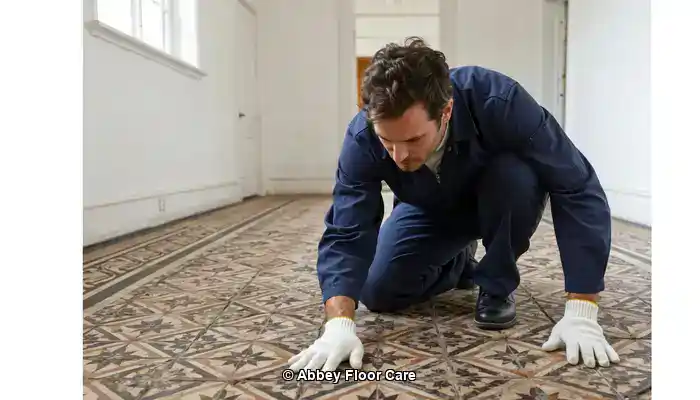
Last Updated on October 30, 2025 by David
Explore Effective Methods to Revitalize Your Faded Victorian Mosaic Tiles
- Victorian mosaic tiles often experience a significant loss of colour due to a buildup of ingrained dirt, outdated coatings, and surface wear. This deterioration is often more a result of neglect rather than age, leading to dull and lifeless tiles.
- Harsh chemicals and aggressive scrubbing can dangerously strip away the original pigments. This is especially problematic for encaustic and geometric tiles, which are particularly sensitive to such abrasive treatments, often resulting in irreversible damage.
- Safe restoration begins with a thorough cleaning process that employs gentle pH-neutral solutions and low-speed rotary machines fitted with soft brushes. This approach is essential for preserving the integrity of the tile surfaces while effectively removing dirt and grime.
- The meticulous removal of old sealers and waxes is vital. This step is crucial to revealing the true condition of the tile surface and adequately preparing it for the restoration process.
- Colour enhancement can be achieved using breathable, stone-safe sealers that enrich the tile’s tone without leaving behind an unsightly glossy film. This is important for maintaining the aesthetic appeal of the tiles.
- Professional restoration services can effectively restore the original pigments without resorting to repainting or using artificial colourings, thus preserving the authentic character of the tiles.
- Maintaining restored tiles involves adopting gentle cleaning routines and avoiding any products that contain harsh acids or bleach, which can damage the restored surfaces over time.
- Heritage-sensitive methods are essential not only for protecting the visual aesthetic but also for preserving the historical significance of these beautiful tiles.
Mastering the Art of Restoring Victorian Tiles to Their Original Splendor
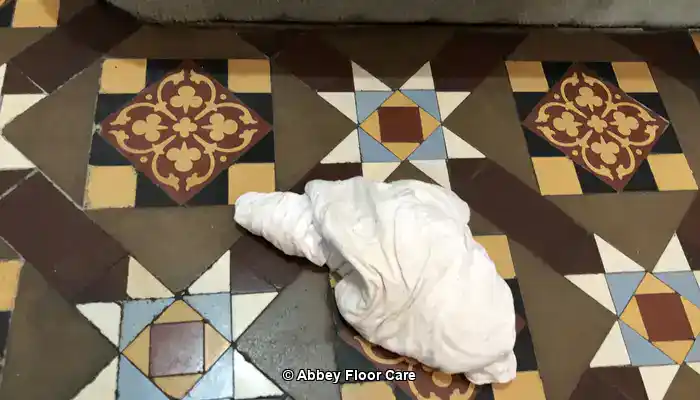
Abbey Floor Care restoring the colour to a Victorian clay tile floor using a colour-enhancing impregnating sealer.
Victorian encaustic and mosaic tiles are invaluable components of British architectural heritage, renowned for their intricate craftsmanship and unique colour palettes created from mineral pigments that are fused into the clay tile bodies. Over time, these exquisite tiles may lose their vibrancy due to factors such as surface wear, chemical reactions, and environmental influences. Effectively restoring their original vibrancy requires specialized knowledge of the materials involved, historically accurate methodologies, and high-quality products specifically designed for tile restoration.
Pro Tip: Recommended Products for Daily Care of Victorian Tiles
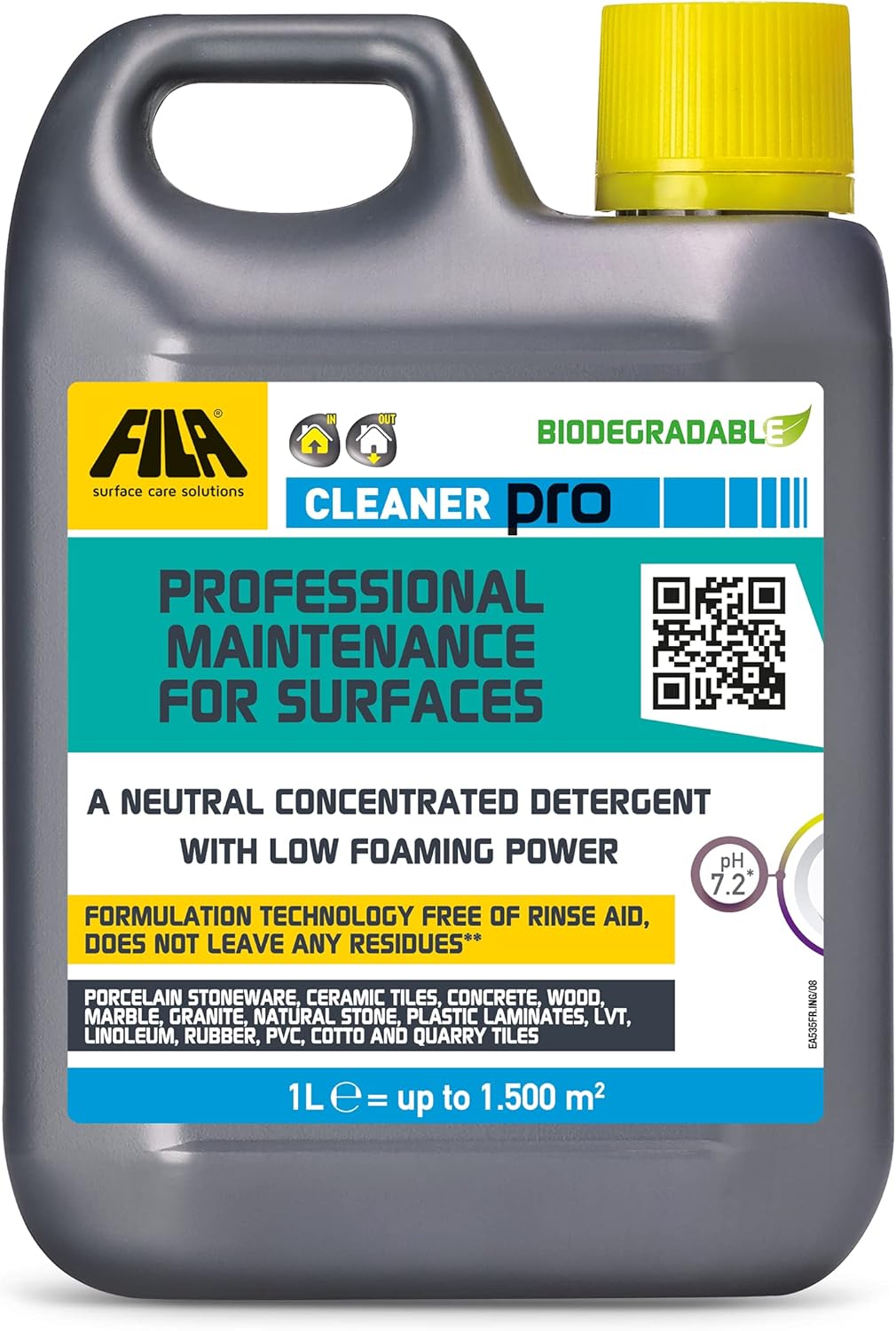
Fila Pro Floor Cleaner
|

LTP Colour Intensifier & Stainblock H20
|

Vileda H2PrO Spin Mop System
|
Over time, however, these tiles often lose their visual impact due to surface wear, chemical effects, and environmental influences. Restoring their original vibrancy is a specialized task that requires an in-depth understanding of the materials involved, historically accurate techniques, and premium products designed specifically for effective tile restoration.
Identifying the Key Factors Behind the Fading and Dulling of Victorian Mosaic Tiles
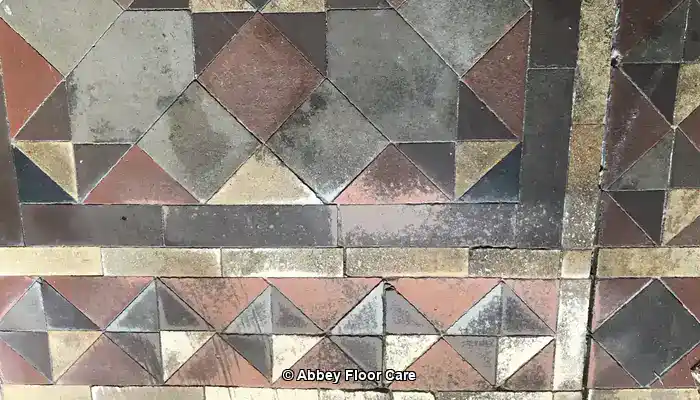
Example of Victorian Clay Tile Floor dulled through surface wear and damage.
Despite the integral nature of the pigments to the tiles, various factors can lead to fading and dulling of their appearance:
- Accumulated dirt and grime: Continuous foot traffic deposits fine particles and oils that penetrate porous surfaces, scattering light and muting the vibrant colours of the tiles, which diminishes their overall aesthetic appeal.
- Wax and polish buildup: Layers of wax or sealants that lack breathability can trap moisture, resulting in a cloudy or yellowed appearance that detracts from the tiles’ beauty and vibrancy.
- Moisture-driven issues: Many Victorian tiles were installed on subfloors without proper damp-proof membranes, leading to rising damp that transports soluble salts. These salts crystallize on the tile surface as efflorescence, further obscuring the original colours and compromising the tiles’ integrity.
- Physical abrasion: Small scratches from years of wear disrupt the smooth reflection of light, diminishing the visual richness of the tiles, which can result in uneven colour distribution.
Effective restoration must carefully address each of these contributors to fading and dulling without compromising the historic integrity of the tiles, ensuring that the essential character and beauty of the tiles are preserved for future generations.
Understanding the Importance of Breathability in Absence of Damp-Proof Membranes
Many Victorian tiled floors rest on older subfloors that lack a damp-proof membrane (DPM), making it essential for their natural clay structure to remain permeable. This permeability allows moisture from the subfloor to evaporate, crucial for maintaining the integrity of the tiles. Non-breathable wax coatings or film-forming sealers obstruct this evaporation pathway, leading to moisture accumulation beneath the surface. Trapped moisture can lead to efflorescence, degradation of surface minerals, and the undesirable phenomenon known as wax blooming—a whitish film or haze forming on the tile. Restoration strategies must prioritize breathable impregnating sealers that protect the tiles while allowing moisture vapour to escape freely, preventing long-term damage and ensuring the structural integrity of the flooring system.
Exploring the Composition and Pigments in Victorian Tiles

An example of different pigments in a Victorian Clay tile floor during restoration by Abbey Floor Care
Identifying Key Mineral Oxide Pigments in Victorian Tiles
Victorian mosaic and encaustic tiles derive their distinctive earthy colours from mineral oxide pigments embedded directly into the clay. These pigments provide both durability and depth of colour, contributing to the tiles’ artistic appeal. The primary pigments include:
- Iron oxide: produces terracotta reds, rust browns, and soft ochres, providing a warm aesthetic to the tile.
- Manganese: yields deep browns and rich blacks, adding depth and contrast to tile designs.
- Cobalt: imparts a range of blue hues, introducing a vibrant splash of colour that enhances the overall design.
- Chromium: creates natural green shades, allowing for a diverse palette in tile patterns.
Impact of the Firing and Fusion Process on Tile Manufacturing
During the manufacturing process, the tiles are fired at temperatures of approximately 1100°C, which vitrifies the clay and fuses the pigments deep within the tile body. This manufacturing technique ensures that the colour penetrates throughout the tile rather than merely resting on the surface, providing a long-lasting vibrancy that endures over time, which is crucial for maintaining the historical integrity of the tiles.
Understanding the Significance of the Porous Unglazed Finish of Victorian Tiles
Victorian tiles are typically characterized by a porous, unglazed matte finish, which contributes to their natural appearance. However, this porosity makes the tiles susceptible to absorption and contamination from moisture and dirt, necessitating careful cleaning and maintenance practices to preserve their integrity and appearance.
Exploring Variability in Colour Durability Among Different Tile Types
Natural earth pigments, especially in red and yellow tiles, contain fewer mineral additives than darker colours such as black, which are formulated with manganese. Consequently, red and yellow tiles tend to be less durable and more prone to surface wear under heavy foot traffic. This wear can manifest as shallow depressions where foot traffic is concentrated, leading to uneven colour intensity and a loss of surface flatness. Understanding these characteristics is crucial for developing effective restoration strategies that take into account the varying durability of tile types.
Key Considerations for Restoring Victorian Tiles
Understanding the composition of pigments and patterns of wear in tiles is fundamental when planning restoration efforts. Softer-toned tiles necessitate gentler cleaning methods and tailored impregnating sealers that respect their physical properties while enhancing their colour. Conversely, darker, harder tiles can withstand more intensive cleaning but still require breathable, colour-enhancing protection to maintain their vibrancy over time, ensuring the longevity and beauty of these significant historical features.
Implementing Effective Cleaning Techniques for Victorian Mosaic Tiles
Effective cleaning is vital for restoring Victorian encaustic and mosaic tiles to their original vibrancy. However, cleaning these tiles requires a specialized approach that goes beyond the use of simple pH-neutral detergents commonly recommended. Professional restorers utilize carefully formulated alkaline cleaners and mechanical techniques to break down heavy soiling and old residues without compromising the historic fabric of the tiles, ensuring both cleanliness and preservation.
What is the Initial Cleaning Step for Tiles?
The cleaning process begins with the removal of all loose dirt and grit using soft brushes or vacuuming with brush attachments. This initial step is essential to prevent scratching the delicate tile surfaces during subsequent cleaning phases, which helps preserve the original integrity of the tiles and prepares them for more intensive cleaning methods.
How to Use Alkaline Cleaners for Intensive Soil Removal Effectively?
Unlike pH-neutral cleaners, which lack the chemical potency needed to tackle ingrained fatty acids and organic soils, alkaline cleaners are indispensable for thoroughly dissolving household oils, grease, and sticky residues commonly found on tile surfaces and within grout lines. These alkaline formulations work by breaking down the binding agents of dirt, sugars, and fats, allowing for effective removal while remaining compatible with the mineral composition of Victorian tiles. Professional-grade alkaline products, such as <em>PS87 PRO</em> or custom formulations from heritage cleaning specialists, are typically used in diluted forms to ensure deep cleaning without overly aggressive action against the clay body, balancing effectiveness with safety.
The Role of Mechanical Agitation in Tile Cleaning
The use of mechanical action enhances the effectiveness of the cleaning process. Low-speed rotary scrubbers equipped with red or, at times, green non-abrasive pads are commonly employed to agitate soils from small pits, tile surfaces, and grout lines. These pads clean thoroughly while safeguarding the integrity of tile edges and delicate surface details, ensuring that the cleaning process does not inadvertently cause damage to the tiles and their intricate designs.
How to Safely Remove Waxes and Exotic Sealants from Tiles?
Years of usage often result in the accumulation of old waxes and sealants, particularly from DIY attempts using unsuitable products. Water-based cleaners—whether alkaline or mildly acidic—are preferred for removing these residues without harming the tile’s mineral structure. However, stubborn ‘exotic’ or solvent-resistant coatings necessitate targeted solvent-based removers such as Lithofin Wax-Off or LTP Solvex. These solvents effectively soften and emulsify waxes and old sealants, but professionals must handle them carefully due to the need for safe application and disposal to mitigate any associated risks.
What are the Thorough Rinsing and Drying Procedures After Cleaning?
After chemical cleaning, it is crucial to conduct thorough rinsing to eliminate all cleaning residues. Multiple rinses with clean water, combined with wet vacuum extraction, ensure that no detergent or solvent traces remain to interfere with subsequent restoration coatings. Drying time varies based on environmental conditions, including humidity, surface type, and moisture levels. Restoration experts always utilize moisture meters to verify that the tiles are completely dry before applying any impregnating sealers or protective treatments. This meticulous approach prevents moisture entrapment, which could otherwise result in efflorescence, staining, or damage beneath sealed layers, thereby preserving the overall quality of the restored tiles.
Why is Thorough Cleaning Essential for Tile Restoration?
Comprehensive cleaning reveals the actual condition of the tiles by eliminating visual obstructions. It exposes areas that may require repair and provides a clean, receptive surface for colour-enhancing impregnators or other restorative products. This careful preparation is fundamental to the success and longevity of Victorian mosaic tile restoration, ensuring that the tiles regain their original beauty and functionality while preserving their historical significance.
Enhancing Colour Using Premium Impregnating Sealers
Restorers utilize impregnating colour-enhancing sealers from renowned brands like <a href="https://amzn.to/40G0qka">LTP</a> and Lithofin, recognized for their advanced, heritage-approved formulations. Unlike superficial coatings, these sealers:
- Penetrate deeply into the tile’s pores to physically enrich colour by altering light refraction, thereby enhancing the visual appeal of the tiles and restoring their vibrancy.
- Maintain vapour permeability, which is crucial for allowing moisture to escape and is particularly important in older floors that lack DPM layers, ensuring the longevity of the restoration.
- Offer durable protection against stains and foot traffic without changing the natural texture or gloss, ensuring that the functional integrity of the tiles is preserved for years to come.
- Applied in multiple light coats, each allowed to penetrate before the next is applied, ensures complete uniformity and optimal colour enhancement throughout the surface.
These sealers effectively combat fading by restoring vibrancy while preserving the breathable nature of the historic floor, making them an essential component of the restoration process to maintain the tiles’ beauty and longevity.
Implementing Physical Repairs for Damaged Tiles and Colour Tinting Techniques
Tiles with chips, cracks, or missing pieces necessitate careful repair using tinted epoxy or lime-based mortars, colour-matched with natural mineral oxides to blend seamlessly with the original tiles. Restoration professionals often source matching replacement tiles from salvage archives to maintain pattern continuity and aesthetic integrity. Colour tinting entails selectively applying earth-pigment-infused wax or resin mixtures to blend worn or missing pattern areas sensitively, while ensuring respect for tile breathability and reversibility, guaranteeing that any repairs made are both effective and discreet, thereby preserving the historic value of the tiles.
Best Practices for Effective Tinting
- Utilize small, controlled applications to avoid over-saturation of colour that may disrupt the tile’s original appearance and lead to uneven colour distribution.
- Conduct patch testing on inconspicuous areas before a complete application to ensure compatibility and achieve desired results, helping to prevent visible mistakes.
- Ensure compatibility with the impregnating sealers applied to the entire surface, maintaining the overall aesthetic and functional quality of the restoration while enhancing the tiles’ longevity.
Essential Maintenance for Restored Victorian Mosaic Floors
To preserve the restored colour and condition of the tiles, ongoing care and attention to detail are imperative:
- Routine cleaning with pH-neutral, non-abrasive detergents specifically designed for historic tiles is essential for maintaining their integrity, appearance, and overall lifespan.
- Preventive measures, such as placing entrance mats to minimize dirt ingress, can significantly reduce wear and tear on the surfaces, extending the life of the tiles.
- Promptly addressing liquid spills, especially acidic substances like vinegar or wine, is critical to prevent surface etching and potential damage, ensuring the tiles remain beautiful and functional.
- Regularly reapplying breathable impregnating sealers every 3 to 5 years, or as needed based on wear, helps maintain protective qualities and prolongs the life of the tiles.
- Monitoring the floors for signs of efflorescence or moisture ingress indicative of underlying damp issues will facilitate early intervention and preservation, protecting the tiles from future damage.
Avoiding Common Pitfalls in Tile Restoration
- Avoid wax treatments that can obstruct breathability, lead to efflorescence, or cause wax blooming, which compromises the tile’s appearance and structural integrity over time.
- Do not utilize acrylic or polyurethane sealants that can trap moisture and cause degradation of the tile, ensuring the longevity of the tiles remains intact.
- Limit the use of harsh chemical cleaners, as they can erode clay and pigments, adversely affecting the aesthetic quality of the tiles and diminishing their historical value.
- Never repaint tiles; paint films alter their visual and physical properties and are irreversible, detracting from their historical significance and authenticity.
- Recognize and address issues in older subfloors before sealing to prevent future complications and ensure successful restoration, safeguarding the tiles for years to come.
Real-World Restoration Projects Showcasing Victorian Tile Expertise
Examples of successful applications of these principles include:
Victorian Hallway Restoration Project in Sheffield
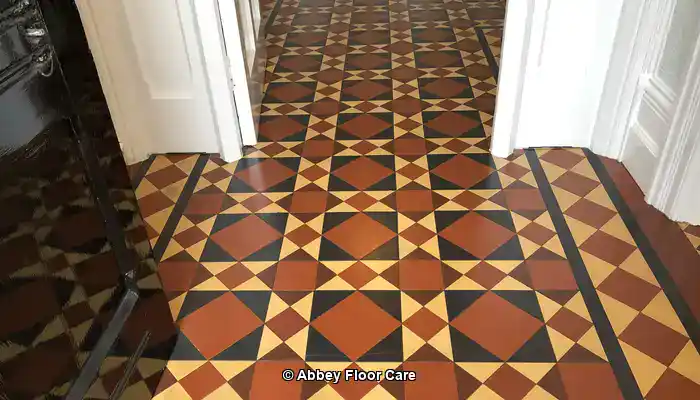
Our cleaning process effectively removed years of wax and grime, followed by the application of a Lantania Avo colour-enhancing impregnating sealer, which visibly deepened the tile colours. This was then complemented by applying an acrylic topical sealer to provide surface protection for floors installed over a damp-proof membrane, showcasing the effectiveness of our restoration techniques and commitment to quality.
Restoration of a Historic Civic Mosaic Floor in Chesterfield
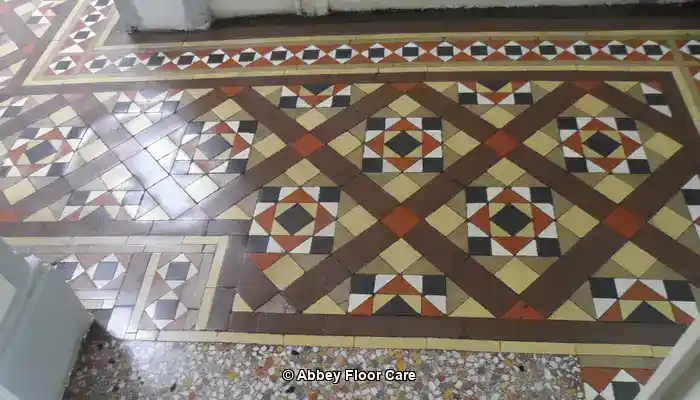
After cleaning and removing old topical sealers, the floor was sealed with an LTP Colour Enhancing Impregnating sealer. The surface was further protected with a wax, which was carefully applied to seamlessly integrate the clay tiles into the historic fabric of the building, exemplifying our commitment to quality and authenticity in restoration.
Preserving Heritage Through Expert Restoration Techniques
Revitalizing the colour and pigment of Victorian mosaic tiles entails a sophisticated balance of material science, craftsmanship, and respect for heritage values. Using premium impregnating colour-enhancing sealers from industry leaders like Dry Treat, Lantania, and Lithofin guarantees long-lasting breathability, protection, and vibrant colour. Skilled cleaning, careful repair, and dedicated maintenance work together to uphold authenticity while rejuvenating these historic floors for future generations to enjoy.
Your Frequently Asked Questions About Victorian Tile Restoration Answered
What Characterizes Victorian Mosaic Tiles?
Victorian mosaic tiles are decorative tiles that gained popularity in the 19th century, known for their vibrant colours and intricate patterns. They were commonly used in public buildings and homes, serving as a testament to the artistic sensibilities of that era and the craftsmanship of tile makers of the time.
How Can I Successfully Restore Faded Victorian Mosaic Tiles?
Restoring faded Victorian mosaic tiles involves a multi-faceted process that includes cleaning, repairing any damages, applying new pigments to match the original colours, and sealing the tiles to protect them. This comprehensive approach ensures that the tiles regain their former glory while preserving their historical integrity and aesthetic value.
What Essential Materials Are Required for Tile Restoration?
Key materials necessary for tile restoration encompass specialized cleaning solutions, pigments, adhesives, grout, and protective sealants, all selected for compatibility with the original tiles to facilitate effective restoration without compromising their integrity and historical significance.
How Long Does the Tile Restoration Process Typically Take?
The length of time required for tile restoration can vary significantly based on the size and condition of the area being restored, generally ranging from a few days for smaller projects to several weeks for larger restorations necessitating extensive work and care, ensuring quality results.
Can I Undertake the Restoration Myself?
Yes, smaller restoration projects can be pursued as a DIY if you possess the requisite skills and tools; however, more complex repairs necessitate expertise to ensure quality results and prevent potential damage to the tiles during the process.
What Are the Typical Costs Associated with Restoring Victorian Mosaic Tiles?
Costs can vary considerably based on project size and condition, typically ranging from a few hundred to several thousand pounds for comprehensive restorations, reflecting the complexity and labour involved throughout the process to achieve successful outcomes.
How Do I Select the Right Restoration Expert?
When choosing restoration professionals, look for those with experience in historical projects, positive reviews, and a commitment to using authentic materials and techniques to deliver high-quality results in your restoration efforts, ensuring that your tiles are treated with the utmost care.
What Challenges Do Restorers Commonly Encounter?
Restorers frequently encounter challenges such as matching original colours, repairing damaged tiles, and ensuring the longevity of the restoration work while maintaining both historical accuracy and aesthetic appeal of the tiles, which requires both skill and knowledge.
How Can I Maintain Restored Tiles Effectively?
Regular cleaning with pH-neutral products, avoiding harsh chemicals, periodic resealing, and prompt addressing of any damage are crucial for maintaining restored tiles, ensuring their beauty and durability for years to come while preserving their historical value.
What Recent Innovations Are Present in Tile Restoration?
Recent advancements include cutting-edge cleaning solutions, novel types of sealants, and digital technology that facilitates precise colour matching and pattern replication in restoration projects, thereby enhancing the effectiveness and efficiency of the overall restoration process, ensuring high-quality results.
The Article Restoring Colour and Pigment to Faded Victorian Mosaic Tiles was first found on https://www.abbeyfloorcare.co.uk
The Article Restoring Faded Victorian Mosaic Tiles to Their Original Colour appeared first on https://fabritec.org
The Article Restoring Victorian Mosaic Tiles to Their Original Color Was Found On https://limitsofstrategy.com

